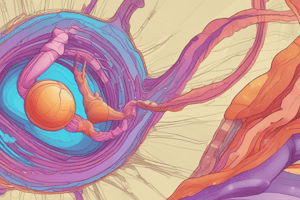Podcast
Questions and Answers
The Krebs cycle occurs in the cytoplasm of the cell.
The Krebs cycle occurs in the cytoplasm of the cell.
False (B)
During the Krebs cycle, a 6 Carbon compound is formed from a 4 Carbon compound and an acetyl group.
During the Krebs cycle, a 6 Carbon compound is formed from a 4 Carbon compound and an acetyl group.
True (A)
The Electron Transport Chain requires oxygen to function.
The Electron Transport Chain requires oxygen to function.
True (A)
The Krebs cycle releases carbon dioxide and hydrogen atoms as waste products.
The Krebs cycle releases carbon dioxide and hydrogen atoms as waste products.
The net gain of ATP from glycolysis is 4 ATP for each glucose molecule broken down.
The net gain of ATP from glycolysis is 4 ATP for each glucose molecule broken down.
The Krebs Cycle requires oxygen to occur and primarily takes place in the mitochondria.
The Krebs Cycle requires oxygen to occur and primarily takes place in the mitochondria.
The Electron Transport Chain generates ATP through a series of redox reactions and does not require external energy.
The Electron Transport Chain generates ATP through a series of redox reactions and does not require external energy.
Anaerobic respiration produces more ATP compared to aerobic respiration.
Anaerobic respiration produces more ATP compared to aerobic respiration.
The main purpose of the Krebs Cycle is to convert ADP into ATP.
The main purpose of the Krebs Cycle is to convert ADP into ATP.
Oxygen is a final electron acceptor in the Electron Transport Chain.
Oxygen is a final electron acceptor in the Electron Transport Chain.
ATP is created directly in the Krebs Cycle through substrate-level phosphorylation.
ATP is created directly in the Krebs Cycle through substrate-level phosphorylation.
Both aerobic and anaerobic respiration result in the complete breakdown of glucose into carbon dioxide and water.
Both aerobic and anaerobic respiration result in the complete breakdown of glucose into carbon dioxide and water.
The main energy currency in cells is NADH.
The main energy currency in cells is NADH.
The Electron Transport Chain takes place in the cytoplasm of the cell.
The Electron Transport Chain takes place in the cytoplasm of the cell.
Isocitrate is a key intermediate in the Krebs Cycle that is formed from acetyl-CoA.
Isocitrate is a key intermediate in the Krebs Cycle that is formed from acetyl-CoA.
Flashcards are hidden until you start studying
Study Notes
Formation of ATP
- ATP is formed by adding a third phosphate to ADP, requiring energy.
- This energy is stored in the high-energy bond of ATP.
- Metabolism produces waste materials such as urea, carbon dioxide, and water, which are eliminated through excretion.
Stages of Respiration
-
Glycolysis:
- Involves the breakdown of glucose (6-carbon) into two pyruvate (3-carbon) molecules.
- Occurs in the cytoplasm and does not require oxygen.
- Uses 2 ATP to initiate, producing 4 ATP for a net gain of 2 ATP per glucose.
-
Krebs Cycle:
- Pyruvate enters the mitochondrion, releasing CO₂ and forming acetyl coenzyme A.
- Acetyl group combines with a 4-carbon compound, forming a 6-carbon compound which loses CO₂ and produces ATP in the process.
- The cycle recycles coenzyme A and involves oxidation of hydrogen atoms.
-
Electron Transport Chain:
- Takes place in the cristae of mitochondria and requires oxygen.
- Electrons from hydrogen atoms move through carrier molecules, releasing energy to generate ATP.
- Final reaction combines electrons and hydrogen ions with oxygen to form water.
Types of Respiration
-
Anaerobic Respiration:
- Occurs without oxygen, producing lactic acid in animals and small energy yields.
- Common in muscle cells during intense exercise when oxygen is limited.
-
Aerobic Respiration:
- Requires oxygen to convert organic compounds into usable energy.
- Produces a significant amount of ATP, with glucose and oxygen generating carbon dioxide and water.
Metabolism
-
Metabolism encompasses all chemical reactions in living cells.
-
Anabolic Reactions:
- Build complex molecules from simpler ones, relying on ATP for energy.
- Processes like photosynthesis and protein synthesis are examples.
-
Catabolic Reactions:
- Break down complex molecules into simpler components, releasing stored energy to regenerate ATP.
Functions and Energy Cycle of ATP
- ATP stores energy from reactions like respiration and photosynthesis for cellular use.
- Transports energy to areas of need within the cell, converting back to ADP and phosphate when energy is released.
Equation of Aerobic Respiration
- The process of aerobic respiration can be summarized as:
- C₆H₁₂O₆ + 6O₂ → 6CO₂ + 6H₂O (Glucose + Oxygen = Carbon Dioxide + Water)
Anaerobic Respiration (Fermentation)
- Fermentation is the anaerobic breakdown of sugars, yielding minimal ATP.
- It serves as a biotechnological process, utilizing bacteria and fungi.
- Advantages:
- Provides energy in low-oxygen environments.
- Disadvantages:
- Produces only 2 ATPs compared to 38 in aerobic respiration and generates toxic byproducts requiring excretion.
Uses of Fermentation
- Employed in alcohol production, baking, yogurt, and cheese making.
- Essential in producing antibiotics, insulin, human growth factors, and clotting factors.
Practical Investigation (Yeast and Ethanol Production)
- Prepare a 10% glucose solution (400 ml) and split into two flasks (200 ml each).
- Add 5g of yeast to one flask for fermentation; the other acts as a control.
- Use fermentation locks half-filled with water for monitoring gas production.
Studying That Suits You
Use AI to generate personalized quizzes and flashcards to suit your learning preferences.




